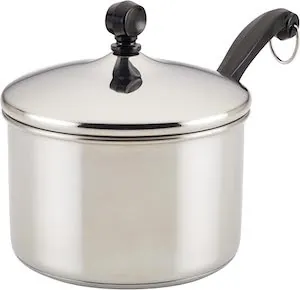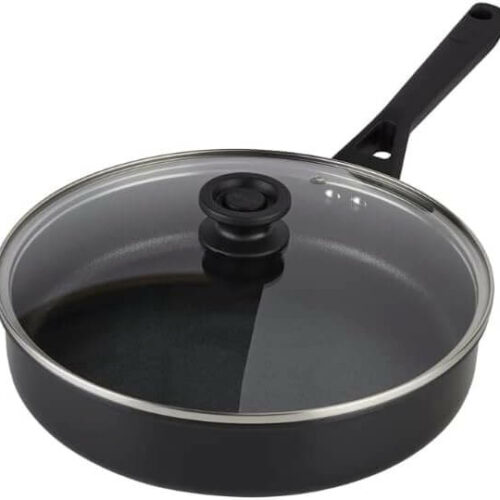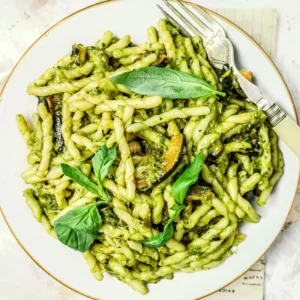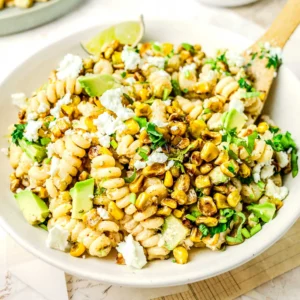Pasta alla Siciliana
Tender aubergine meets melty mozzarella — it’s a romance, it’s a recipe — in this melty, savoury, fresh Neapolitan twist on Sicily’s beloved pasta alla norma. This is pasta alla Siciliana.
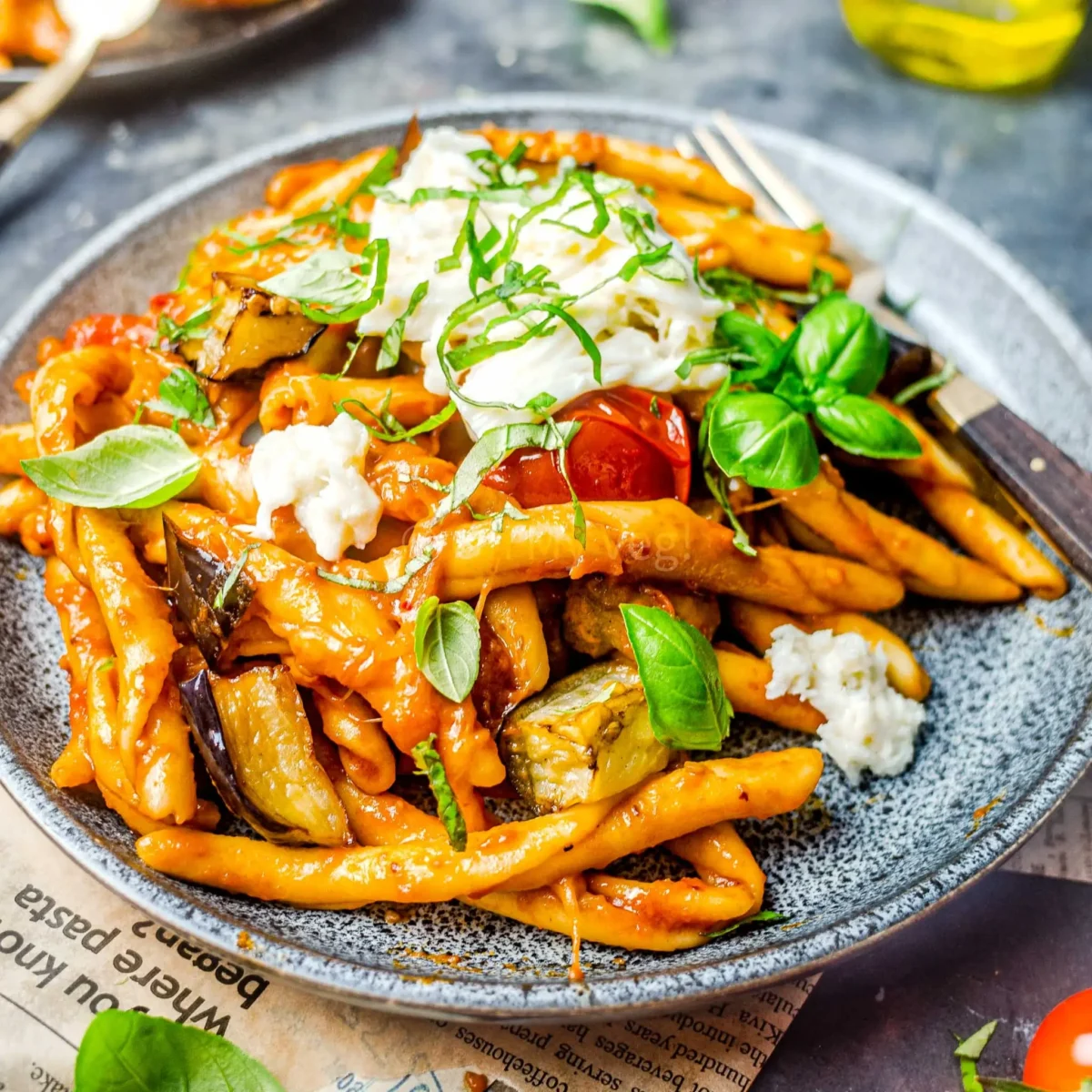
I wasn’t expecting much when I ducked into a tiny trattoria in Naples. The place had charm, but it looked like it hadn’t been decorated since the 1970s — I just needed somewhere to rest my feet and refuel (anyone who has holidayed in Europe knows the pain of a 20,000 daily step count!).
Naples is an experience. Properly, unapologetically loud and busy and gritty. Compared to the elegance of Florence, the quiet secret calle of Venice, the lazy mountain towns of the Alps, and the historical beauty of Rome, it felt like someone had turned the volume up on everything — the traffic, the voices, and even the food.
I’d already fallen hard for the pizza (grabbed a slice from a roadside stall, almost got run over, and ate it on the train to Pompeii — I still dream about that pizza), but I was about to fall harder. This pasta dish was (is) exceptionally good.
And if you’re wondering why I’m talking so much about Naples when this dish is called pasta alla Siciliana, it’s because the dish isn’t authentically Sicilian.
It’s the Neapolitan take on the classic pasta alla norma … AKA, it has the best tasting tomatoes of your life and plenty of fresh buffalo mozzarella.
The smell hits you before you even pick up your fork. It’s the smell of Nonna’s kitchen: garlic infusing into olive oil, the rich sweetness of bubbling tomatoes, and freshly torn basil.
Then you dig in and discover little pockets of jammy, caramelised aubergine that have soaked up all that gorgeous sauce. And when you lift that first forkful and watch the mozzarella stretch into impossibly long strings, that’s when you realise you’re in trouble — the good kind of trouble, where you might just eat another plate (🤫)!
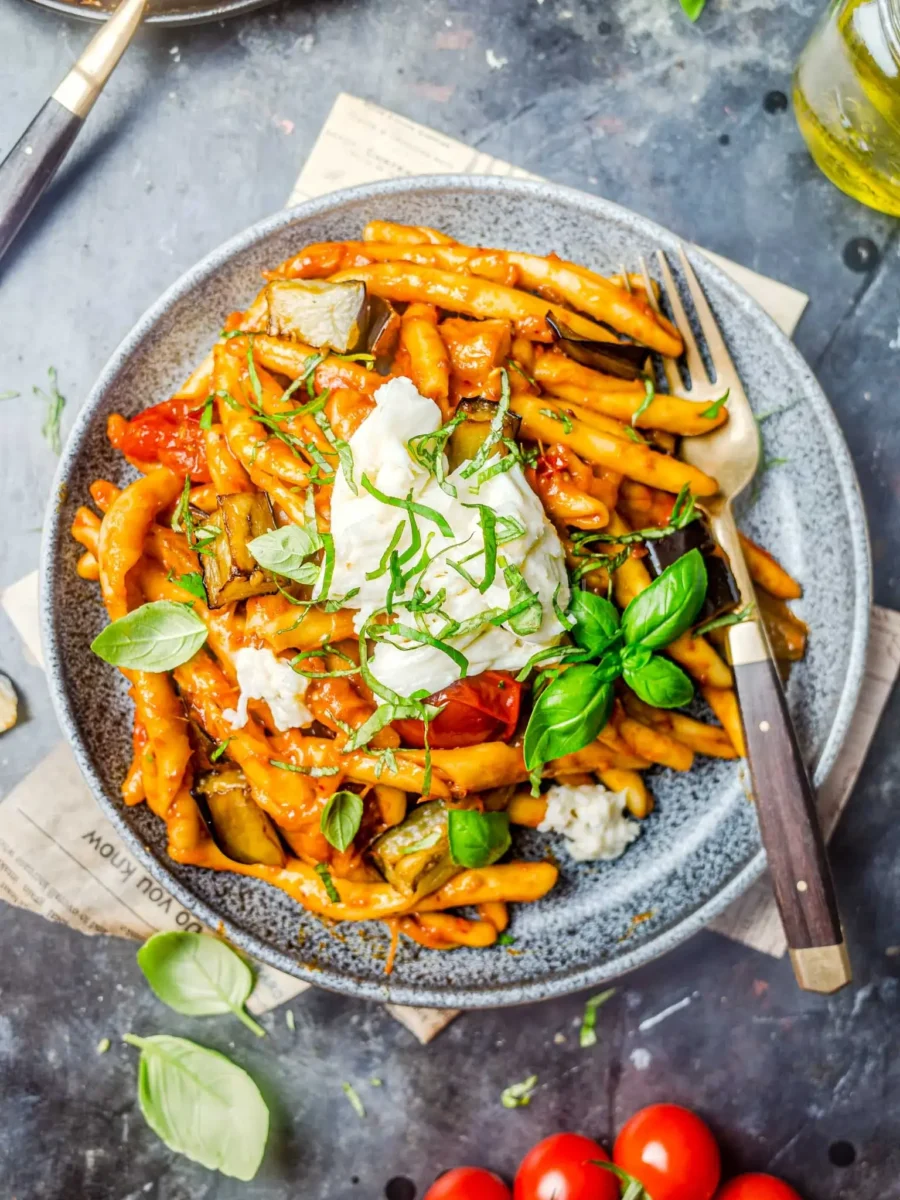
😍 Why Pasta alla Siciliana Is Your New Favourite Dish
❓What is Pasta alla Siciliana?
Pasta alla Siciliana is a Neapolitan interpretation of the Sicilian classic dish pasta alla norma (more on that below).
It’s made by tossing pasta with a lightly spiced, garlicky tomato sauce, fried aubergines, and fresh herbs. Pieces of creamy mozzarella are melted on top, and at the last second stirred right through to create that gooey, stringy mess that’s awfully delicious.
Pasta alla Siciliana vs Pasta alla Norma vs Pasta Melanzana: What’s What?
Pasta alla Siciliana is often confused with its more famous cousin, pasta alla norma.
While they share similar DNA, they’re distinctly different dishes: Pasta alla norma hails from Catania in Sicily and traditionally features pasta cooked with aubergine (eggplant), tomato sauce, basil, and ricotta salata (a lovely aged and salted ricotta with a sharp, tangy taste).
Compared to its inspiration, the sauce of pasta alla Siciliana tends to be a bit more robust, and the overall dish feels heartier. It celebrates Naples’ love affair with mozzarella, creating the gloriously melty texture that makes this dish so addictive!
Another similar dish is pasta melanzana. It’s a broad term for any pasta dish that features aubergine (melanzana being the Italian word for aubergine), encompassing dozens of regional variations across Italy.
I usually make pasta melanzana as a lighter dish, with cooked-down fresh tomatoes, long pasta, and a grating of pecorino to finish. Plus the obligatory aubergine, of course.
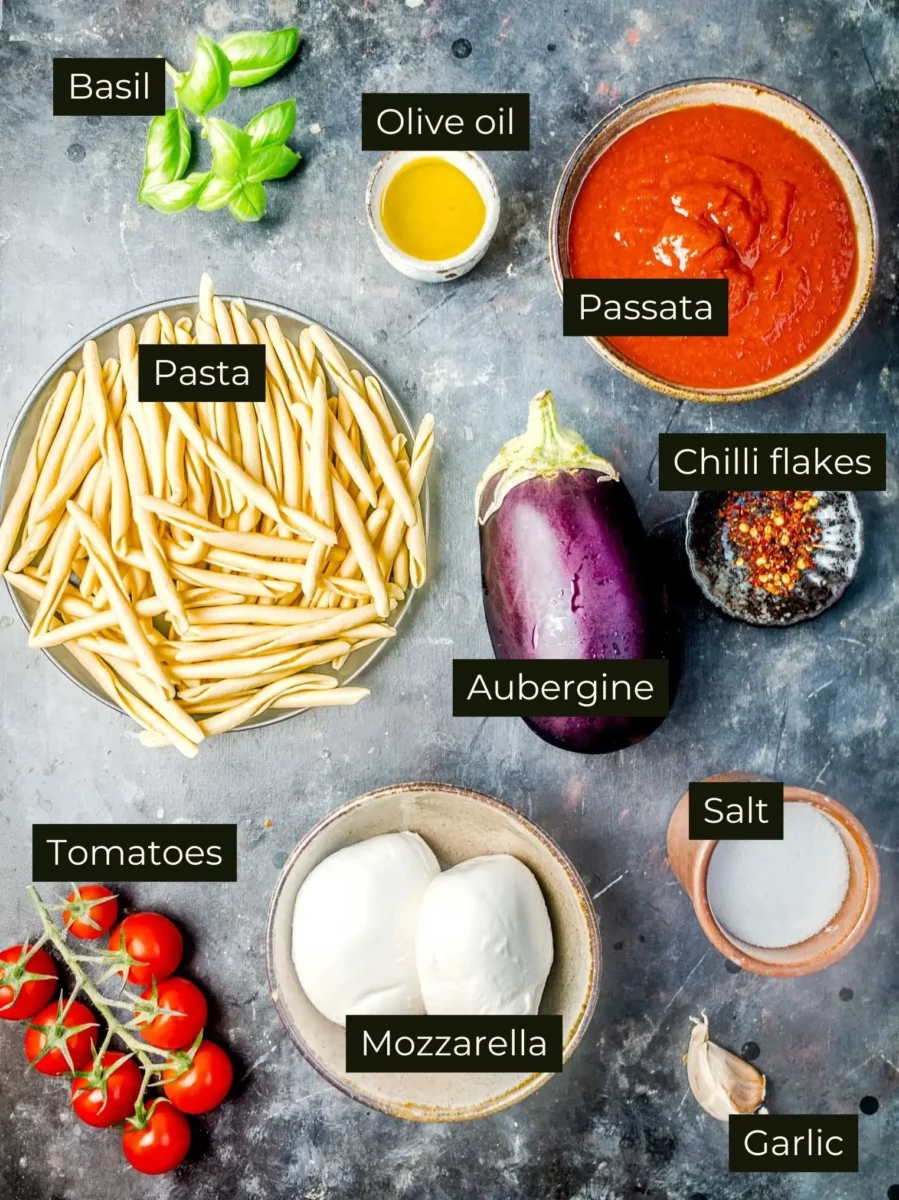
🍝 What Ingredients You’ll Need for Pasta alla Siciliana
This recipe proves that the best Italian cooking doesn’t need complicated ingredient lists — just quality basics treated with respect. Each component plays its part in creating that perfect balance of flavours and textures.
- Aubergine (eggplant): The star of the show! I recommend Italian aubergines for authenticity; they also boast a sweeter flavour, more tender flesh, and a smaller size. However, American eggplants will be great too! The important thing is to choose a firm, glossy vegetable with no soft spots.
- Pasta: I use dried pasta, but fresh is even better. Not all pasta shapes are made equally; check the section below for my suggestions.
- Salt: Essential for properly seasoning the pasta water. Use more than you think you need — the water should taste like the sea.
- Olive oil: Use the best extra virgin olive oil you can find here. I like to use Italian olive oil for Italian dishes!
- Garlic: Just one clove provides that gentle aromatic base without overpowering the delicate aubergine. Slice it rather than crushing to keep the flavour subtle.
- Red chilli flakes: A tiny amount adds warmth rather than heat. This isn’t meant to be a spicy dish, just one with a gentle background tingle that warms up the palate.
- Passata: Good quality passata makes all the difference.
- Fresh tomatoes: I’ve used heirloom piccolo vine tomatoes, but fresh San Marzano tomatoes would taste just as good; they add little bursts of sweetness and acidity that brighten the whole dish. Having fresh tomatoes in the sauce makes all the difference.
- Fresh basil: The classic partner to tomatoes and aubergine. Tear rather than chop to prevent bruising and add it at the end to preserve that bright, peppery flavour.
- Mozzarella: This is what makes the dish. Use proper mozzarella di bufala if you can — when it hits the warm pasta, it melts into these incredible stretchy ribbons that coat everything.
What Type of Pasta is Best?
I’ve used maccheroni al ferretto, a long rolled pasta originating from Calabria in Southern Italy. The sauce clings to it just beautifully.
However, you could use some Sicilian favourites such as ziti, maccarruna, casarecce, and rigatoni; all great options! Even penne — one of the most affordable and accessible varieties of pasta worldwide — would be fantastic with this dish.
Have you noticed a pattern? I recommend using short to medium tubular-shaped pasta for this recipe. Longer varieties (like spaghetti) don’t pair well with the tender chunks of aubergine and don’t absorb the delicious umami flavours of the sauce as well, either.
Why I Use Passata, Not Tinned Tomatoes
Most recipes floating around the internet recommend using tinned tomatoes for pasta dishes like pasta alla Siciliana.
I’d always blindly followed the advice, and the result was disappointing. In fact, tomato-based pasta was always my least favourite.
Then I started using passata in my dishes. Instant improvement.
If you aren’t familiar with passata, it’s made from strained tomatoes (usually Roma or San Marzano varieties). While tomato purée (or tomato paste, in some areas) has the water cooked out, passata is lovely and loose.
It generally has a higher tomato percentage than canned/tinned tomatoes, which often have added preservatives. It’s also much easier to use, since it’s already smooth!

Adapting This Recipe For Allergies and Dietary Requirements
Making pasta alla Siciliana vegan is surprisingly straightforward (and equally as delicious!).
To make this recipe vegan, replace standard mozzarella di bufala with a vegan version that boasts great meltability. While I was in the U.S., I used and loved Miyoko’s liquid pourable mozzarella, while in the U.K., MozzaRisella is my go-to. That’s the only change needed!
To make this recipe gluten-free, swap the wheat pasta for your favourite gluten-free alternative. Chickpea or lentil-based pasta works particularly well here, as its slightly nutty flavour complements the aubergine beautifully. Just be mindful of the different cooking times.
As you can see, it’s undeniably effortless to adapt pasta alla Siciliana for different dietary needs.
Plus, the dish is soy-free, nut-free, and alcohol-free by default.
🍄🟫 5 Ways to Change Up this Recipe
- Add more vegetables: Fold in roasted courgettes (zucchini), roasted peppers, mushrooms, or raw spinach to make a more vegetable-forward pasta. It’ll add depth to the aubergine base and help you hit your 5-a-day goals!
- Protein boost: Stir through canned/tinned chickpeas, cannellini beans, or butter beans. They’ll soak up the rich tomato sauce and add hearty creaminess in addition to protein. Or, why not serve a breaded tofu (or tofu schnitzel) sliced on the side? Yum!
- Switch up the herbs: Basil is classic, but fresh mint or parsley gives a slightly different freshness that still feels very true to Sicily. Even fresh oregano would be a hit.
- Nutty crunch: Toasted pine nuts or almonds scattered on top just before serving add both texture and flavour, not to mention the nutritional benefits.
- Breadcrumb topping: A very Sicilian touch! Fry breadcrumbs with a little olive oil and garlic, then sprinkle over the pasta for a rustic, crunchy finish. This is called pangrattato (it’s also fantastic on my cavolo nero pasta).
🧑🍳How to Make Pasta alla Siciliana (Step-by-Step Photos)
This is proper weeknight cooking! The whole thing takes less than 30 minutes from start to finish, and if you can chop an aubergine and boil pasta, you’ve got this dish sorted.
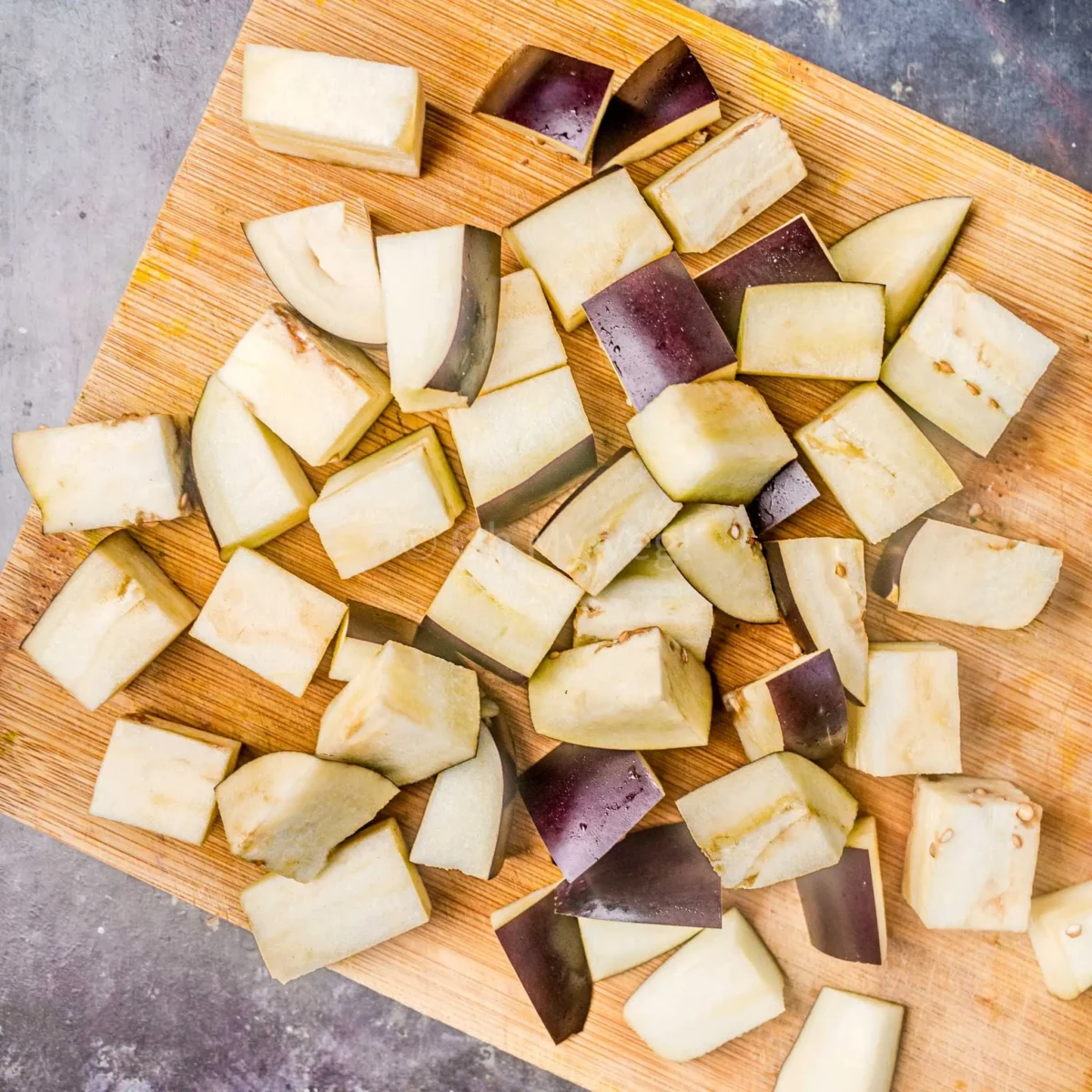
One: Cut your aubergine into large chunks. No need to peel the skin!

Two: Fry in preheated oil until golden. You can also bake the aubergine.
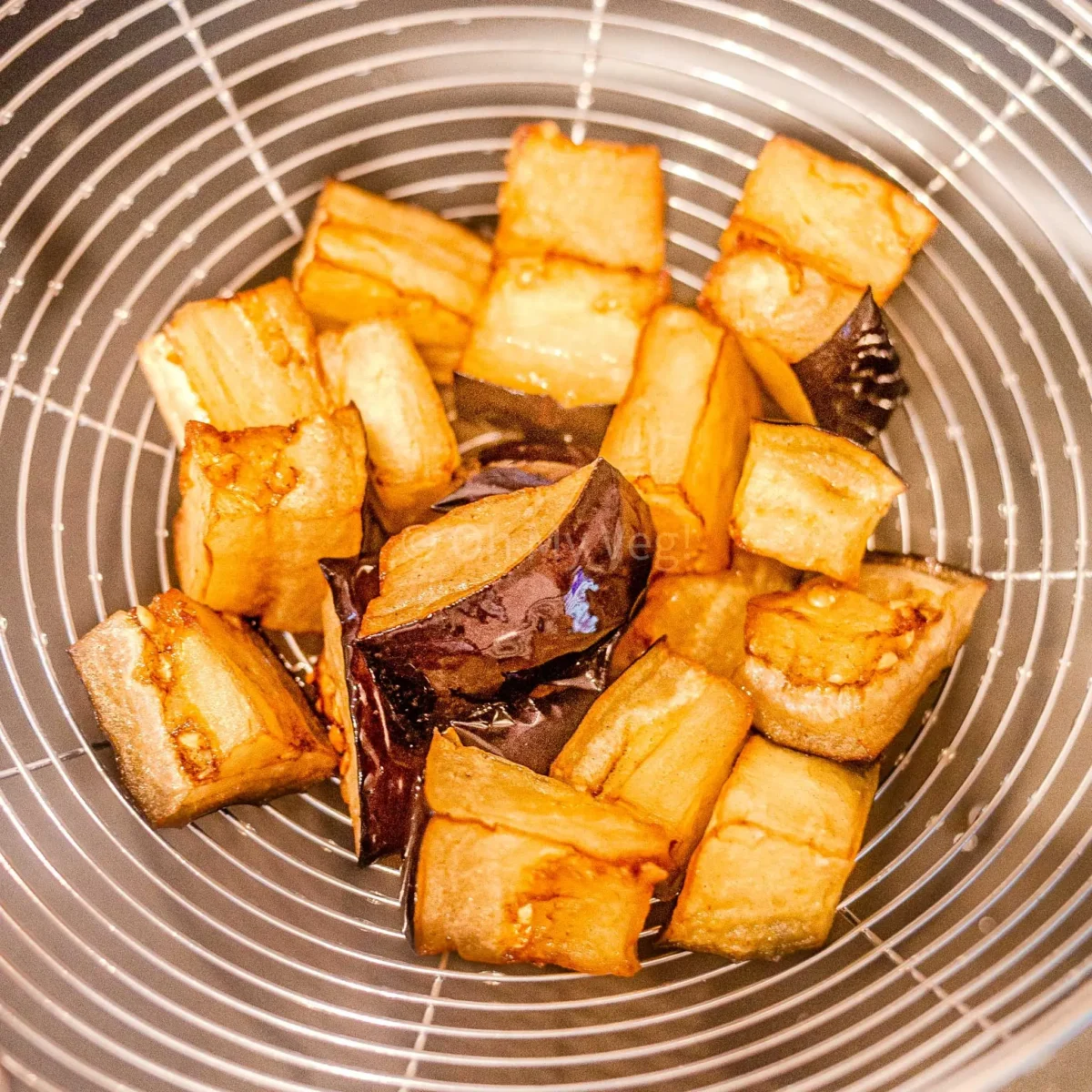
Three: Drain the cooked aubergine chunks to remove excess oil.
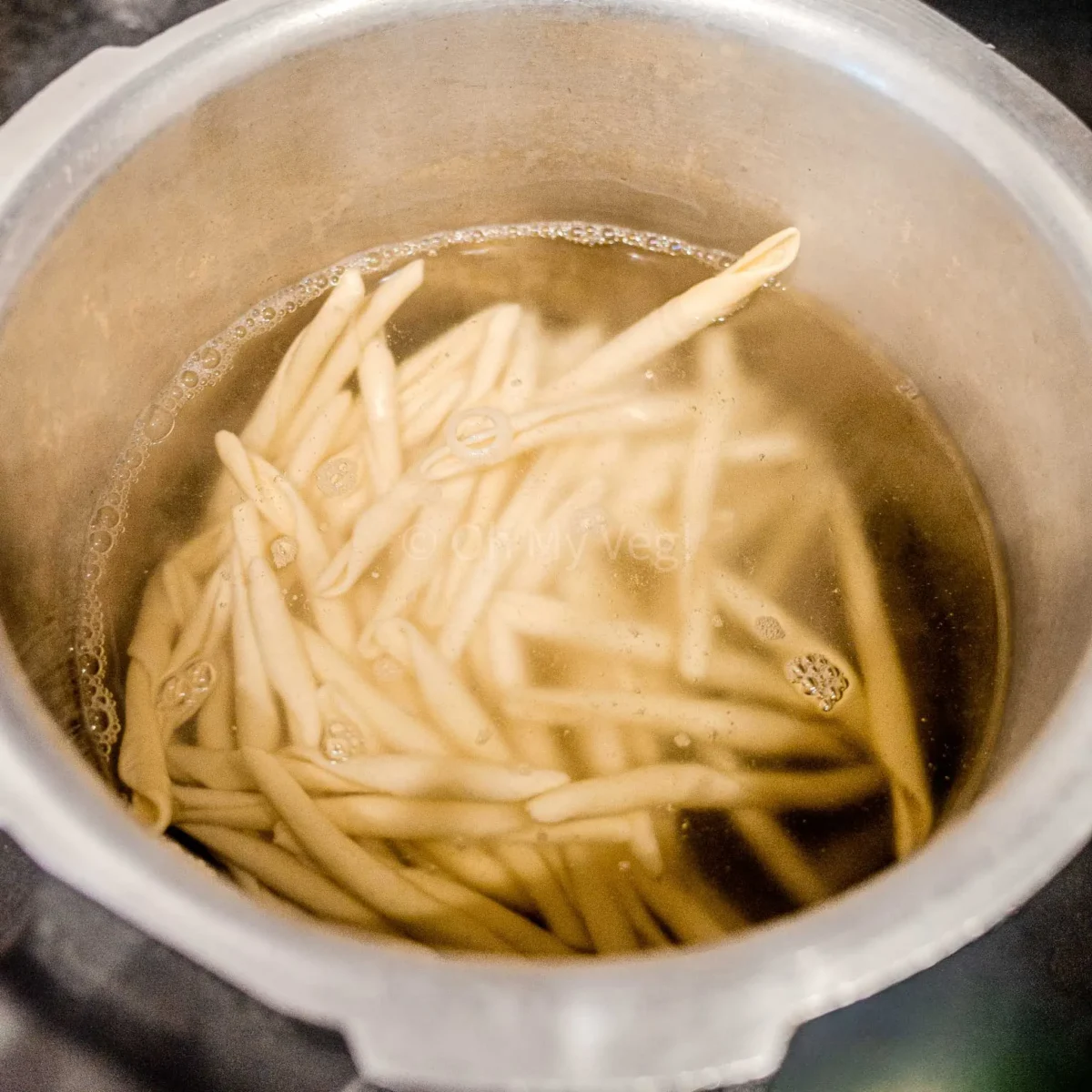
Four: Add the pasta to boiling salted water and cook according to package directions.
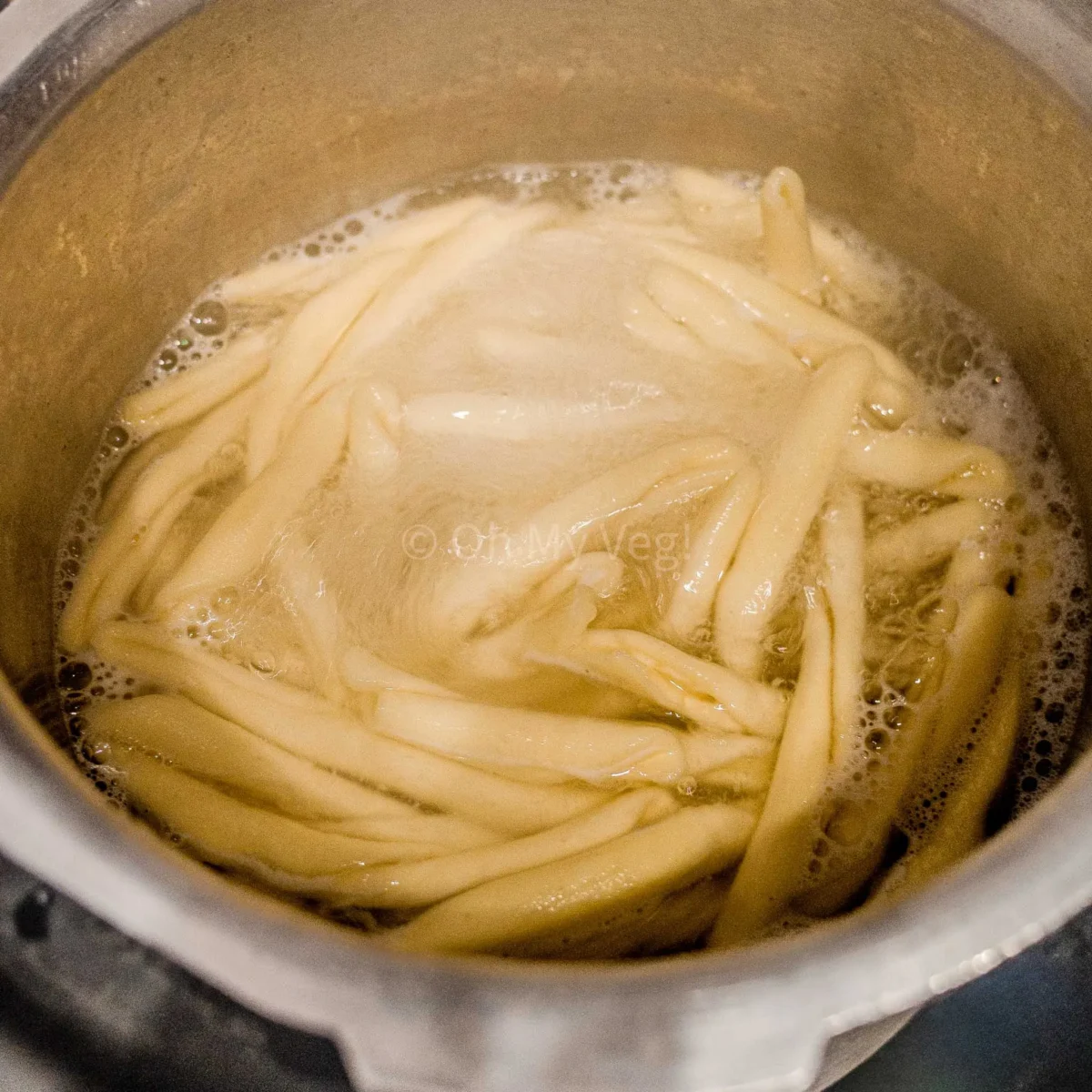
Five: Once al dente, strain the cooked pasta, but reserve the pasta water.
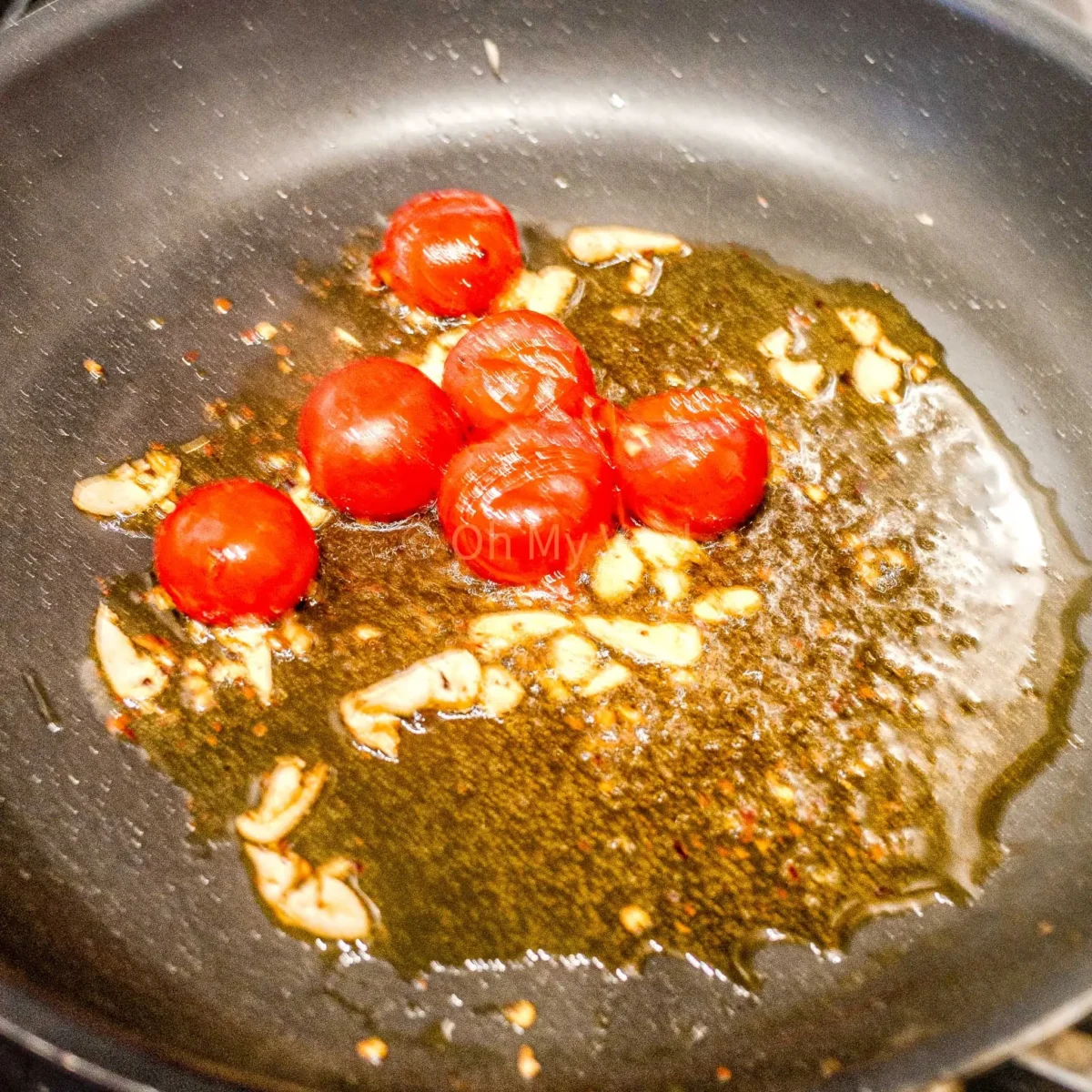
Six: In a large pan, heat olive oil. Add your garlic cloves, chilli flakes, and tomatoes. Let them infuse with the oil.
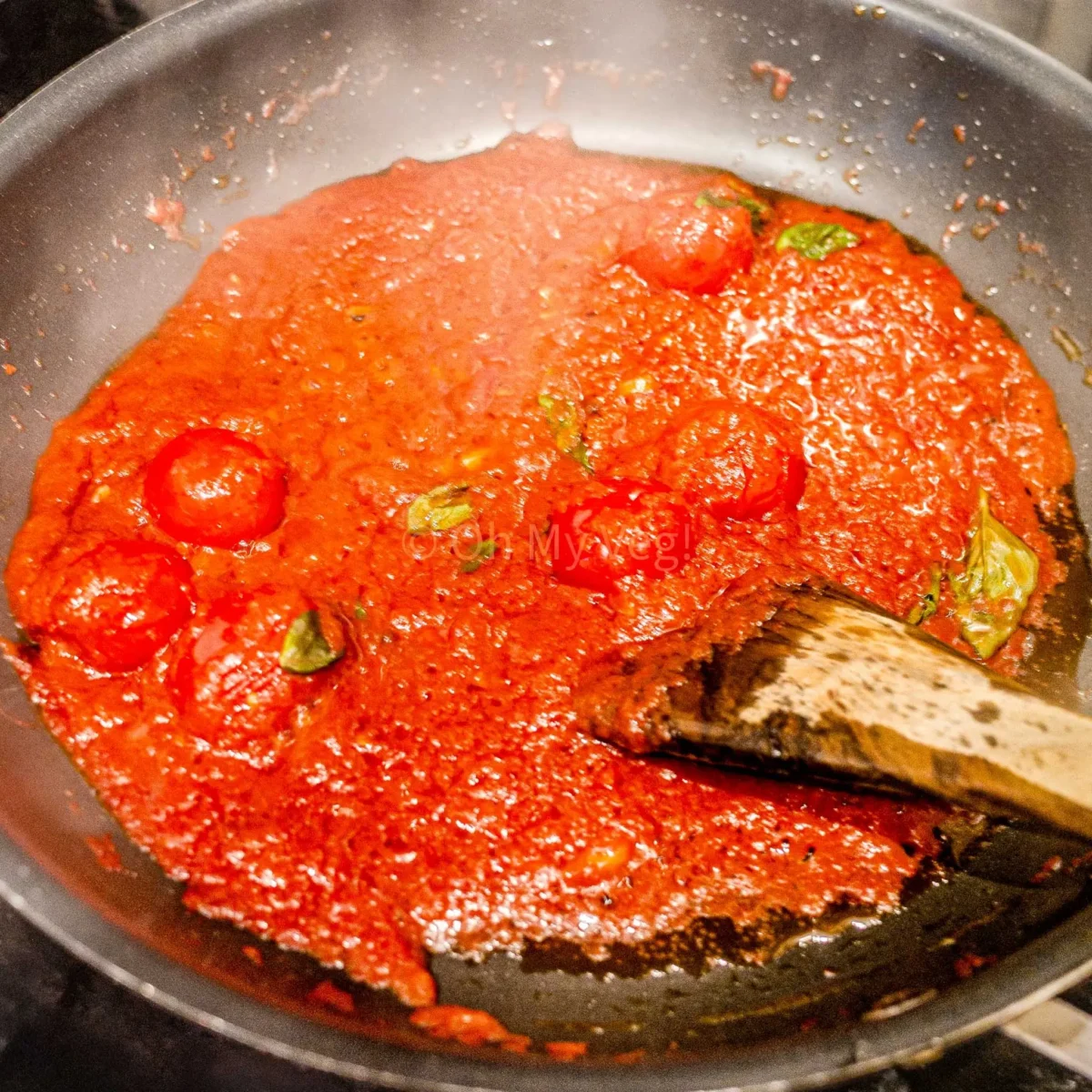
Seven: Add the pasta and a few pieces of torn basil. Cook for a few minutes until beautifully savoury.
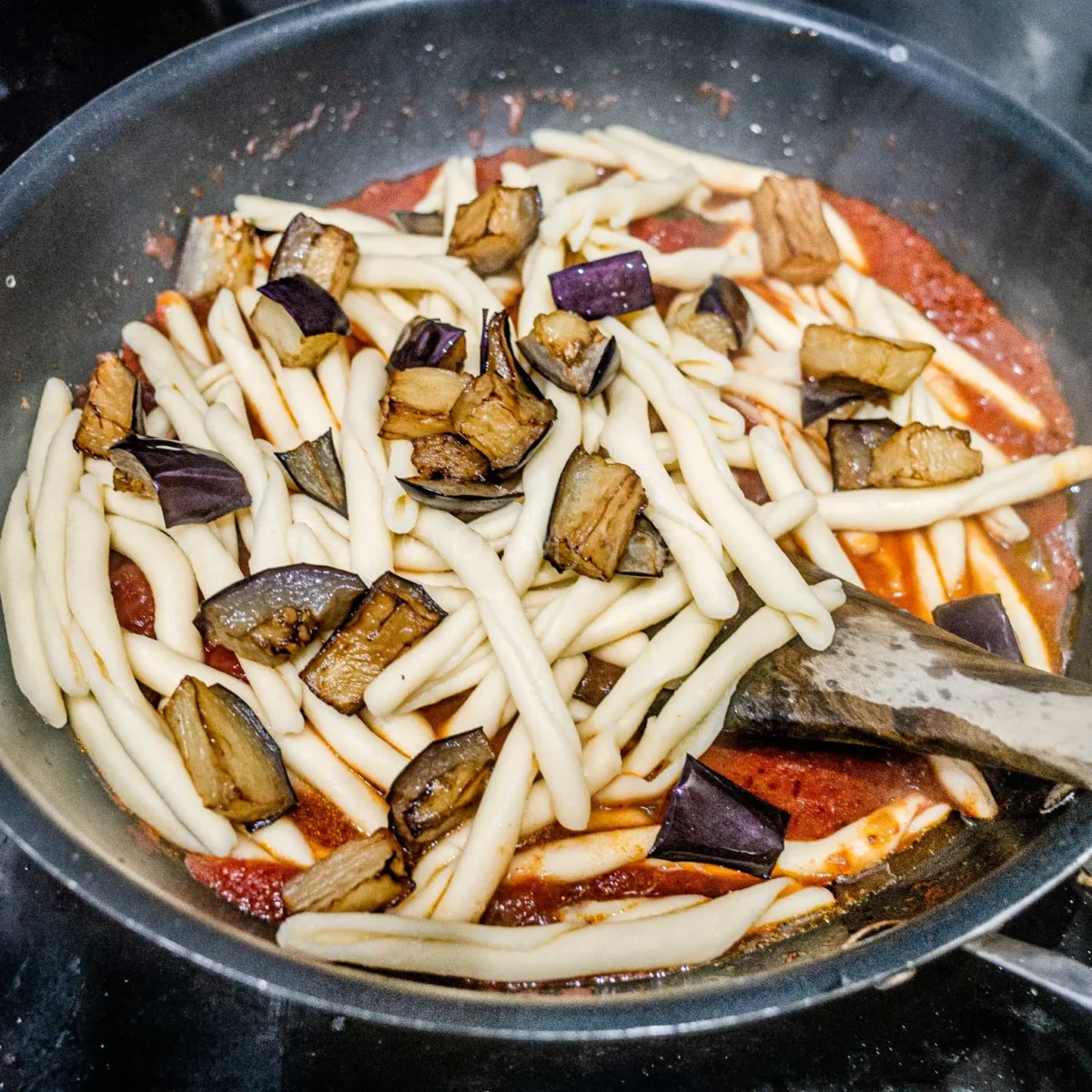
Eight: Add the drained pasta and cooked aubergine chunks to the pan.
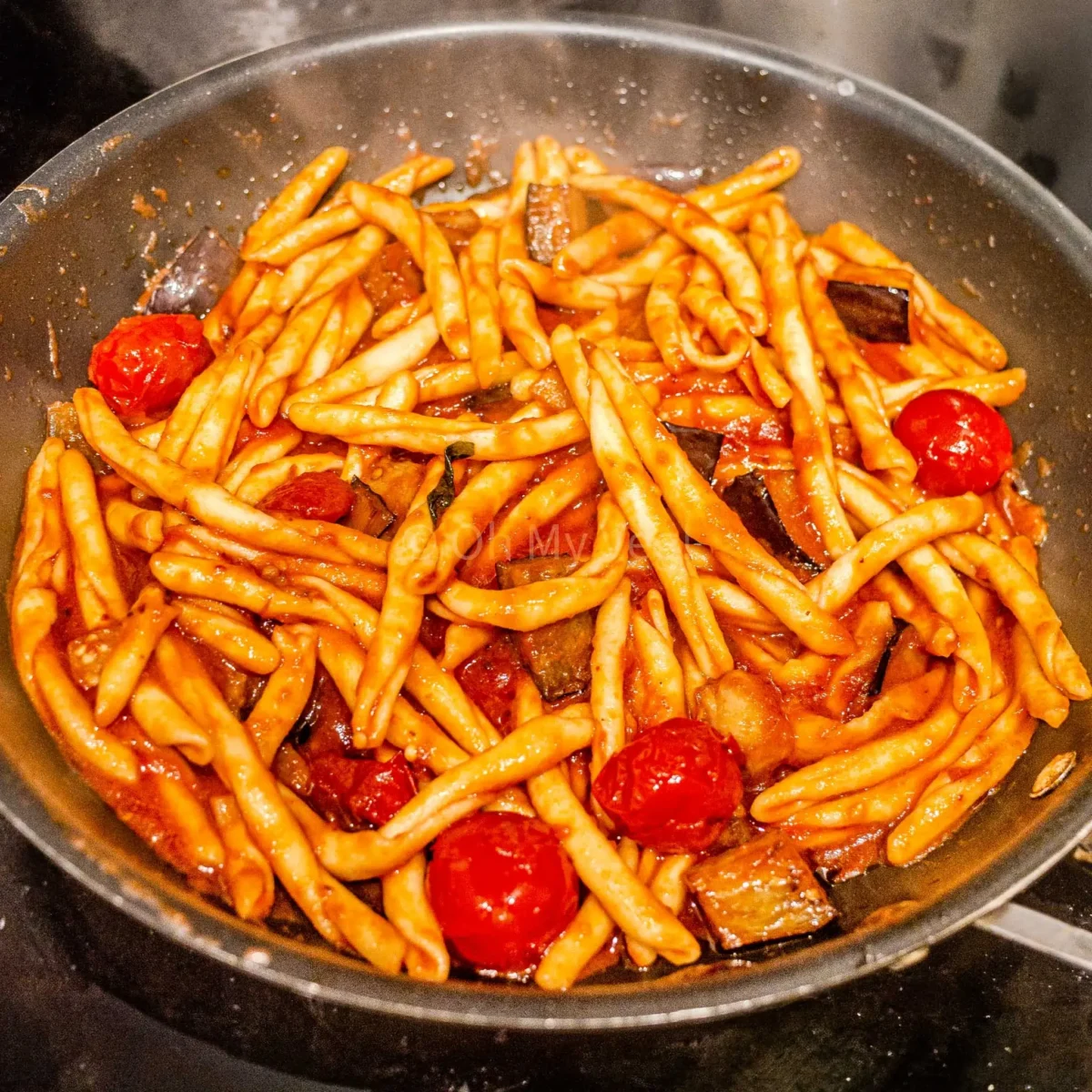
Nine: Mix well and add a splash of reserved pasta water to loosen — only if necessary.
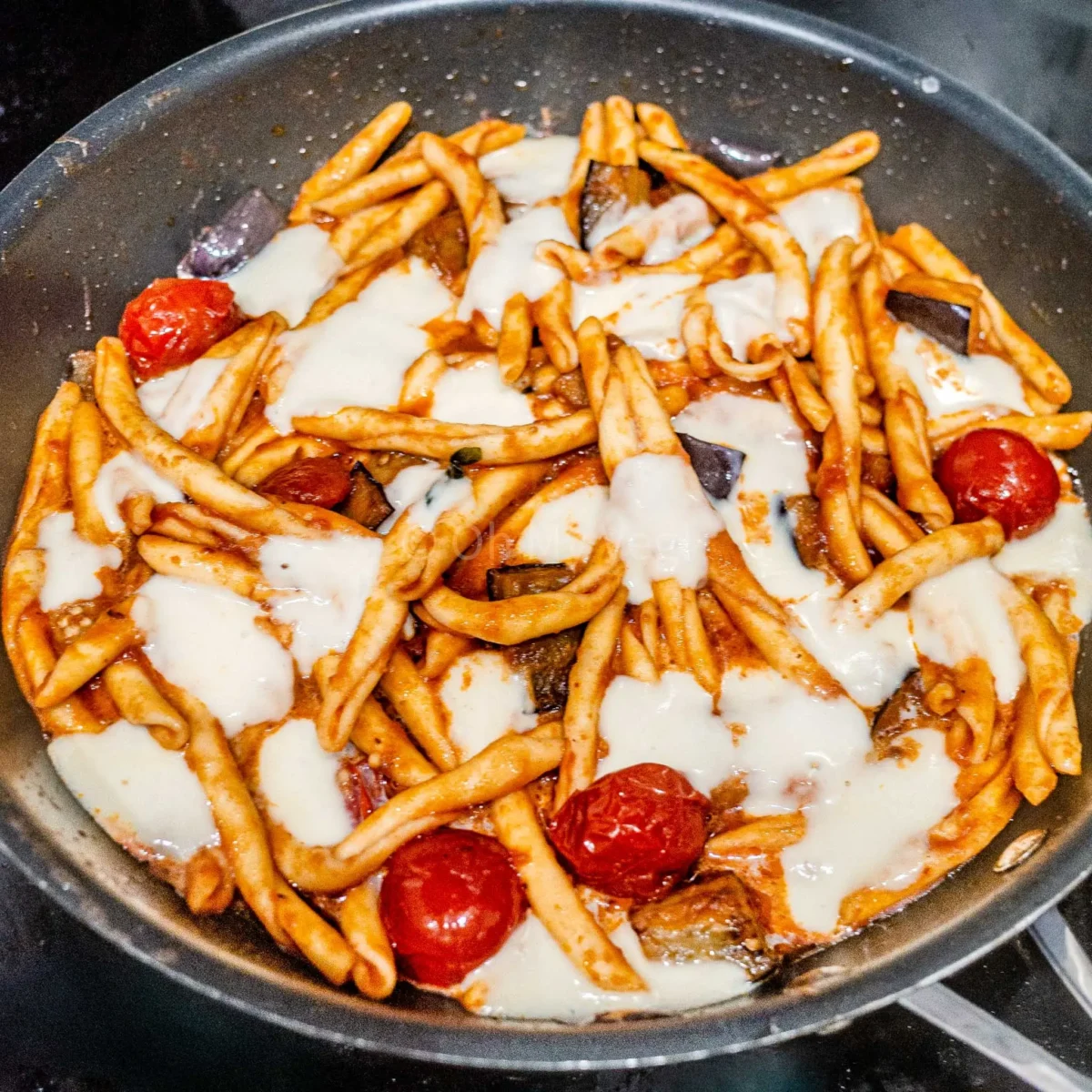
Ten: Add chunks of mozzarella on top of the pasta. Turn off the heat, cover the pan, and let the mozzarella melt. Stir through, then serve.
Remember, the complete recipe (with ingredient quantities and instructions) can be found at the bottom of this page. You can also print the recipe, save the recipe, adjust the servings, and much more from there!
⭐Top Tips for Tasty Plates
- To salt or not to salt: I don’t feel the need to pre-salt my aubergines. For better or for worse, the aubergines we get in the U.K. are never bitter — and it doesn’t seem to have any textural benefits either. On the other hand, if you do frequently have bitter aubergines, salt them after chopping and leave for 10-30 minutes.
- Cooking the aubergine: I choose to deep-fry my aubergine. It’s most authentic to the original recipe. However, you can shallow-fry, pan-fry, or even oven-bake the aubergine (although I find baking dries it out). For non-greasy fried aubergines, don’t overcrowd the pan. Cook in batches if necessary.
- Taste and season at every stage: ALWAYS, always salt your pasta water! If you’ve salted it adequately (as salty as the sea, remember!), this should be enough seasoning for the whole dish. But, if it’s not, salt the dish when you mix the pasta with the sauce, too.
- Use the freshest ingredients: Tomatoes, mozzarella, herbs; all should be as fresh as possible for the best tasting results.

🥣 Storing Pasta alla Siciliana
This pasta alla Siciliana keeps beautifully in the fridge for up to three days. Although the texture changes slightly as the cheese cools, it remains undeniably delicious. Store in an airtight container.
To reheat, gently warm through in a pan. I always like to add a splash of water when reheating, as it helps to loosen the sauce.
While I don’t usually recommend using a microwave to reheat many of my recipes, this is an exception! Cook in short bursts, stirring between each one. It’s particularly effective for getting that cheese gloriously melty again.
I wouldn’t recommend freezing this particular pasta — the mozzarella doesn’t freeze well and the aubergine can become a bit mushy. It’s much better enjoyed fresh or within a few days of making.
🥗 Serving Suggestions For Pasta alla Siciliana
This pasta is hearty enough to serve as a main course with just a simple green side salad (like spinach and arugula salad) and some crusty bread for mopping up any leftover sauce (this actually has a name in Italian: fare la scarpetta!).
For a more substantial meal, serve the dish alongside some antipasti — olives, roasted peppers, and a few slices of vegan salami (yes, it exists, and yes, it’s very good). It also makes an excellent first course to an accompanying secondo (usually meat-based, but lentil-based meatballs or breaded tofu buck tradition in the tastiest ways).
Pasta alla Siciliana is also ideal for feeding a crowd … especially when you want to impress without spending all day in the kitchen! You can scale up this recipe easily by adjusting the servings.
If you tried this pasta alla Siciliana — or any other recipe on my website — please leave a 🌟 star rating and let me know your thoughts in the ✍️ comments at the bottom of the page. Thanks for being a part of my community!

🍆 Pasta alla Siciliana Recipe
Ingredients
- 250 g aubergine (eggplant)
- 1 litre oil for deep frying the aubergine 1
- 200 g pasta
- 2 teaspoon salt for cooking the pasta
- 2 tablespoons olive oil extra virgin
- 1 clove garlic
- ¼ teaspoon red chilli flakes
- 50 g small tomatoes I used piccolo, san marzano are also great 3
- 250 ml passata
- 1 sprig basil
- 200 g mozzarella drained weight
- 50 g mozzarella drained weight, for serving
Instructions
- In a large saucepan or deep fat fryer, heat 1 litre oil until it reaches around 180℃ (355℉). 1
- Cut 250 g aubergine (eggplant) into large chunks. Once the oil is hot, fry the aubergine for a few minutes until golden. Drain off any excess oil on a cooling rack, and set aside.
- Add plenty of water and 2 teaspoon salt to a large saucepan over medium-high flame. Bring the water to a rolling boil, then add 200 g pasta2. Let the pasta cook until al dente. Drain the pasta, but reserve a mug of its cooking water. While the pasta cooks, I recommend continuing on with the other steps.
- In a large frying pan over medium heat, add 2 tablespoons olive oil . Once hot, add 1 clove garlic (sliced), ¼ teaspoon red chilli flakes, and 50 g small tomatoes 3. Let the aromatics sauté gently until the oil is infused, then immediately add 250 ml passata and 1 sprig basil (leaves roughly torn, stem discarded).
- Let the passata cook for five minutes or so, stirring now and then.
- Add the cooked pasta and aubergines to the pasta sauce. If necessary, add a dash or two of the reserved pasta water to loosen the sauce. Mix well and taste for seasonings; if more salt is needed, add it now, then turn off the flame.
- Cut 200 g mozzarella into chunks. Scatter over the top of the pasta and cover with a lid. Let the pasta cook for a minute or two, until the mozzarella melts, then stir through.
- Serve the pasta alla Siciliana with 50 g mozzarella on top of each serving and more fresh basil.


